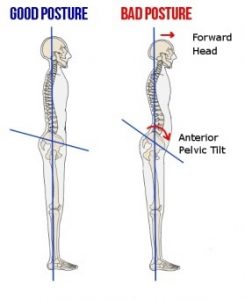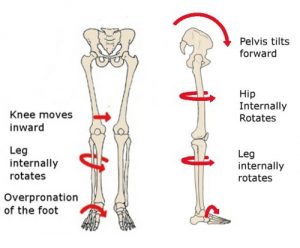Written by: Sebastian Mann Bach. Exercise and Sport Science (current)
What is Anterior Pelvic Tilt?
Anterior Pelvic tilt (APT) is a postural condition where the orientation of the pelvis in respect to the femurs (thigh bones) and the rest of the body is moved or tilted forward away from its neutral or correct position and becomes the resting position of the pelvis.
What causes Anterior Pelvic Tilt?
This musculoskeletal condition is extremely common in modern society. APT is identified when an individual displays excessive arching in the lower/lumbar spine. The onset of APT is largely due to the typical behaviors of todays society which involves most people sitting for multiple hours a day. However it can also be brought on by activities such as bike riding, although bike riding is a form of physical activity the hips are still forced into a flexed position.
When we are force our bodies into this position on a regular basis, there are a number of muscles within our body that change in length. The first change noticed is our hip flexors shorten, because of this, the lower region of the erector spinae have no option but to compensate for this and also shorten whilst our gluteal muscles lengthen.
Furthermore, weak abdominals which start at the front of the pelvis and attach to the ribs can also compliment the onset of this condition, their role is to stop the pelvis from tilting forward and when our hips are in this flexed position, our abdominal muscles tend to become.

Does this affect the rest of the body?
APT can have a significant impact an individual’s entire lower body movement mechanics as well as thoracic and cervical spine.
Upper Body:
As shown In figure one, the lumber region of the spine is in a hyper-extended position. When it is in this position it causes a chain of effects going up the spine. The thoracic spine (upper back) will naturally want to drop back further to make up for the forward curvature of the lumbar (lower back) and because of this, the cervical spine (neck) will consequently want to drop forward cause the head to drop forward to make up for the alteration in the thoracic region. The overall change creates a more pronounced S shape in the spine which can potentially lead into more musculoskeletal problems depending on the individual.
Lower Body
The anterior tilt in the pelvis causes the hips to internally rotate which causes the knees to drift inwards to the middle of the body which in turn causes the lower half of the leg below the knee to internally rotate and potentially causing over pronation of the foot. These biomechanical changes to the lower body can also leading on to muscle imbalances in the lower limbs specifically excessive hip adductor (inner thighs) and gastrocnemius (calf) activity.

How can I fix Anterior Pelvic Tilt?
ATP treatment in particular involves fixing muscle imbalances relative to the pelvis. This means doing the opposite to these muscles when the pelvis is tilted forward It is also important to note that whilst the goal is to perform strengthening exercises eventually, individuals must begin with light activation exercises, and build to more difficult movements over time or incorrect technique and recruitment of the wrong muscle groups will occur.
It is also important to note that whilst performing corrective exercises that an “abdominal drawing-in maneuverer” is held through the movement. The way this movement works is that it releases tension off the erector spinae in the lower back and puts the pelvis into the correct position for movement. Imagine drawing your stomach back into your spine and holding this position whilst exercising.
Some corrective exercises for this postural condition include:
- Release and lengthening work on hip flexors including relevant stretches and myofascial release.
- Progressive gluteal activation and strengthing.
For glut max (the major gluteal located at the back and slightly below pelvis responsible for extending the hip/leg behind the body) an example of exercises progression includes:
- Double leg glut bridges progressed into stagged stance (one foot raised higher then another) glut bridges or on an unstable surface followed by single leg bridges.
For glut med (the smaller gluteal muscle located on the left and right side of the responsible for abducting/moving the leg laterally away from the body) exercises can include:
- Leg clams progressed into lateral band resisted walking.
At Inspire Fitness our team of Personal Trainers and Exercise Physiologists incorporate corrective exercise into the training routines of our clients. Addressing these bio mechanical and postural deviations within your body is vital to ensure you significantly reduce the risk of injury whilst exercising; and importantly so you can progress faster towards your general health and fitness goals.
